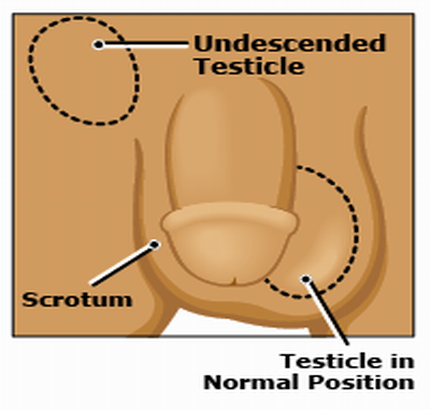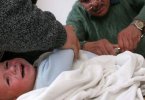What's in this article?
Undescended testicle Overview
Undescended testicle (cryptorchidism) is a testicle that hasn’t moved into its proper position in the bag of skin hanging below the penis (scrotum) before birth. Usually just one testicle is affected, but about 10 percent of the time, both testicles are undescended.
An undescended testicle is uncommon in general, but quite common among baby boys born prematurely.
The vast majority of the time, the undescended testicle moves into its proper position on its own, within the first few months of life. If your son has an undescended testicle that doesn’t correct itself, surgery can relocate the testicle into the scrotum.
Causes of Undescended testicle
Most of the time, a boy’s testicles descend by the time he is 9 months old. Undescended testicles are fairly common in infants who are born early. The problem occurs less often in full-term infants.
Some babies have a condition called retractile testes and the health care provider may not be able find the testicles. In this case, the testicle is normal but is pulled back out of the scrotum by a muscle reflex. This is able to occur because the testicles are still small before puberty. The testicles will descend normally at puberty and surgery is not needed.
Testicles that do not naturally descend into the scrotum are considered abnormal. An undescended testicle is more likely to develop cancer, even if it is brought into the scrotum with surgery. Cancer is also more likely in the other testicle.
Bringing the testicle into the scrotum can improve sperm production and increase the chances of good fertility. It also allows the health care provider to do an exam for the early detection of cancer.
In other cases, no testicle may be found, even during surgery. This may be due to a problem that occurred while the baby was still developing before birth.
Can the testis still descend after birth?
In some cases, the testis that is undescended will still descend after birth. However, this is less likely the older the baby becomes. Both testes should be in the scrotum by the time your child is 1 year old.
How common are Undescended testicles?
- Out of every 100 full-term male babies, 3 are born with undescended testicles.
- Out of every 100 male babies born prematurely (too early), up to 30 are born with undescended testicles.
- Out of every 100 boys with undescended testicles, the undescended testicle cannot be found in up to 5.
Symptoms of Undescended testicle
Not seeing or feeling a testicle where you would expect it to be in the scrotum is the main sign of an undescended testicle.
Testicles form in the abdomen during fetal development. During the last couple of months of normal fetal development, the testicles gradually descend from the abdomen through a tube-like passageway in the groin (inguinal canal) into the scrotum. With an undescended testicle, that process stops or is delayed.
How is an Undescended testis diagnosed?
This is usually found when the baby is examined, either shortly after birth or during the six- or eight-week baby check. This is found by examining the baby’s scrotum gently to feel for the presence (or absence) of the testes.
In some children, the testes may have descended to the scrotum but are not always able to be felt there. This is because the testes can sometimes rise back into the body, especially when the baby is cold. If you can feel both testes in the scrotum at other times – for example, when your baby is having a bath – then your baby does not have undescended testes and does not need any treatment.
Treatment of Undescended testicle
In most cases, the testicle will descend without treatment during the child’s first year. If this does not occur, treatment may include:
- Hormone injections (B-HCG or testosterone) to try to bring the testicle into the scrotum
- Surgery (orchiopexy) to bring the testicle into the scrotum. This is the main treatment.
Having surgery early may prevent damage to the testicles that can cause infertility. An undescended testicle that is found later in life may need to be removed. This is because the testicle is not likely to function well and could pose a risk for cancer.





